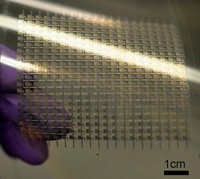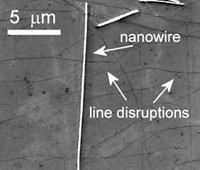Advertisement
Grab your lab coat. Let's get started
Welcome!
Welcome!
Create an account below to get 6 C&EN articles per month, receive newsletters and more - all free.
It seems this is your first time logging in online. Please enter the following information to continue.
As an ACS member you automatically get access to this site. All we need is few more details to create your reading experience.
Not you? Sign in with a different account.
Not you? Sign in with a different account.
ERROR 1
ERROR 1
ERROR 2
ERROR 2
ERROR 2
ERROR 2
ERROR 2
Password and Confirm password must match.
If you have an ACS member number, please enter it here so we can link this account to your membership. (optional)
ERROR 2
ACS values your privacy. By submitting your information, you are gaining access to C&EN and subscribing to our weekly newsletter. We use the information you provide to make your reading experience better, and we will never sell your data to third party members.
Materials
Memory Device Created From Polymer Pair
Organic Electronics: Two functional polymers form the heart of a high-capacity, low-power memory device
by Neil Savage
April 9, 2014

Electronic paper, which is a display that looks like ink printed on paper, could be less expensive if made with organic electronics instead of silicon-based electronics. But one obstacle to building such carbon-based devices is the lack of efficient organic memory. Now European scientists report a high-capacity, low-power memory device made out of organic polymers (ACS Nano 2014, DOI: 10.1021/nn406503g).
Nonvolatile memory in computers and other devices can store information even when the electronics are off. Conventional nonvolatile memory encodes the binary data using materials that can be switched between two electronic states. Alain M. Jonas, a professor at the Catholic University of Louvain, in Belgium, and his colleagues created an organic version of nonvolatile memory that stores bits in an array of nanodots of a ferroelectric polymer. Ferroelectric materials are electrically polarized, and that polarization can be flipped by applying a voltage. So for these so-called ferrodots, the two directions of polarization represent the 1 and 0 of binary information. To read out the stored information, the device measures current flowing through a thin film of a polymer semiconductor surrounding the ferrodots. The direction of polarization in the ferroelectric polymer affects how easily current flows through the semiconductor.
To build their memory device, the team started with a silicon substrate and created an electrode out of either poly(3,4-ethylenedioxythiophene):polystyrene sulfonic acid or highly boron-doped polycrystalline diamond. They then added a layer of the ferroelectric polymer, poly(vinylidene fluoride-ran-fluoroethylene), and used nanoimprinting techniques to stamp the material into an array of 250-nm-wide dots spaced 150 nm apart. They coated the device with a layer of a semiconducting polymer, poly(3-hexylthiophene), filling in the spaces between the nanodots. Finally, the researchers added a second electrode made of silver on top of the device.
Tests of the device showed the polarization of the nanodots could be flipped with a voltage just over 2 V and read with 1.5 V. Those low voltages make for a low-power memory device that’s appropriate for applications such as radio-frequency identification tags, Jonas says.
He says other researchers previously had attempted to build a similar structure by creating a solution of ferroelectric and semiconducting polymers, spin-coating the solution onto a substrate, and then waiting for the polymers to dry and separate. The result, though, was a relatively coarse device, with large islands of ferroelectric material spaced irregularly. That device had a total capacity of only about one-eighth of a kilobyte. The new ferrodot device has a capacity of 0.2 gigabytes per cm2. Jonas says shrinking the nanodots to about 80 nm could probably improve the memory density, though dots that small are more likely to adhere to the mold used to make them.
Yang Yang, head of the organic electronic materials and devices group at the University of California, Los Angeles, calls the work “a brilliant method for the control of phase separation of two dissimilar organic materials.” Such fine-grained control of structure is promising not only for memory but also for other electronics, such as solar cells and light-emitting diodes, he says.





Join the conversation
Contact the reporter
Submit a Letter to the Editor for publication
Engage with us on Twitter